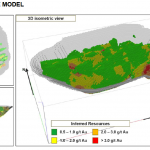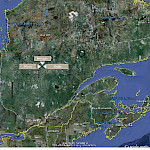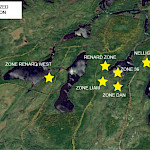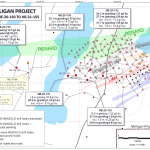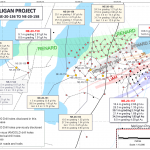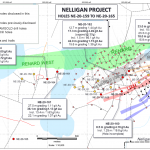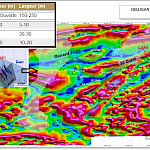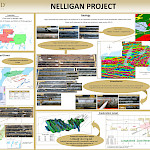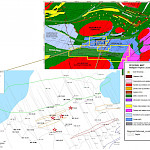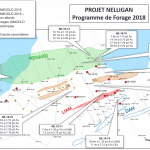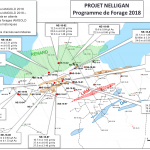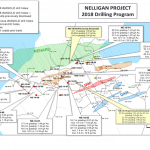Nelligan is one of Quebec’s largest gold projects containing approximately 3.2 million ounces of gold. The project is located 60 kilometres southwest of Chibougamau, Quebec, and is located within 50 km of significant infrastructure, including electricity, railroads, a workforce, an airport, and other services. The property consists of a total of 158 mining map-designated cells and covers 8,216 hectares. The ore body presents itself in a vast auriferous hydrothermal system and is open along strike to the west and at depth.
Nelligan Project
Property Agreement
- Joint venture is owned 75% by IAMGOLD and 25% by Vanstar
- IAMGOLD can acquire an additional 5% (80% total) by completing a feasibility study at its expense.
- Vanstar would retain a 20% undivided non-contributory carried interest until commencement of commercial production and a 1% NSR on the 8 original claims
- IAMGOLD funds development through to production
Resource Estimate
Mineral resource estimate for the Nelligan project at a cut-off grade of 0.5 g/t for an open pit mining scenario.
| Resource Category | Zones | Tonnage (t) | Grade (g/t Au) | Gold Ounces (oz) |
|---|---|---|---|---|
| Inferred | Dan | 1,525,000 | 1.00 | 48,900 |
| Liam | 2,939,000 | 1.47 | 139,100 | |
| 36 | 809,000 | 0.87 | 22,500 | |
| Renard | 91,716,000 | 1.01 | 2,983,400 | |
| Total | 96,990,000 | 1.02 | 3,193,900 |
43-101 Technical Report - October 22, 2019 (View PDF)
To date, over $15M has been invested in the Nelligan project since 2013.
Regional Geology
The Nelligan Property is geologically located in the NE part of the Abitibi Greenstone Belt of the Superior Province. All rocks of the region are Archean in age except for Proterozoic diabase dikes. The Nelligan Property cover’s a small area of the large Caopatina segment belonging to the North Volcanic Zone of the Abitibi Belt. The property is centered on the E-W Druillette synclinal. This synclinal consists of the sediments of the Caopatina Formation resulting from the erosion of volcanic rocks and located in the central portion of the property. The sedimentary formation is bounded to the north and to the south by sub-marine volcanic rocks of the Obatogamau Formation and are of tholeiitic composition (basalts and gabbros). The North and South portions of the property are occupied by granodioritic to tonalitic intrusions. Granitic intrusions in the region belong to two groups: synvolcanic plutons observed in the core of regional anticlines, and syntectonic plutons. The synvolcanic plutons, typically polyphased, were emplaced before the regional deformation and are linked to the genesis of the volcanic sequences. The region was affected by the Kenorean orogeny which resulted in the formation of regional folds and the development of a main E-W schistosity. Important deformation corridors are related to EW faults and ductile-brittle NE faults which affect the entire Caopatina-Caopatina segment such as the Guercheville Deformed corridor located 5km north of the property.
In the Desmaraisville segment, the faults are grouped into 4 groups based on direction and overlapping relationships: EW, SE, NE, and NNE faults. The EW and SE longitudinal faults are the oldest and associated with the regional schistosity of the main deformation episode. The NE faults cut the regional schistosity and structures related to the EW faults. Late NNE faults are commonly related to the Grenvillian orogeny to the east.
The EW faults, mainly represented by the Kapunapotagen and Guercheville faults, are parallel to the trend of the regional schistosity and are typical of the east trending ductile faults that crosscut the Abitibi Subprovince (Cadillac-Larder, Casa Berardi, Detour deformation zones). They are generally characterized by pure shear with dextral reactivation with widths up to 1km as well as characterized by an intense schistosity, the presence of mylonitic zones, and carbonate- and sericite-rich alteration.
The NE faults are well documented in the Fancamp Deformation Corridor between the Eau Jaune Complex and the Verneuil Pluton and has an average width of 600m, steeply dipping (80°) toward the SE. Several gold showings, such as the Chevrier deposit ((1.8Mt at 5.1g/t), Phillibert deposit (1.5Mt at 5.4g/t) are spatially associated and the only mine in the eastern part of the Caopatina-Desmaraisville segment was the former Joe Mann mine which produced 4.7Mt @ 8.26 g/t Au and 0.3% Cu.
Local Geology
On the local scale, the Nelligan project contains several gold showings including Liam and Dan Zones discovered by drilling in 2013 ( drill hole NE-13-04 ( Liam ) – 20.7m @ 2.04 gt / Au ) and 2014 ( drill hole NE-15-26 ( Dan ) – 10.20m @ 2.47 gt / Au ) and the historical Lake Eu showing with grades of 2.17 g/t Au and 3.5 g/t Au (drill holes 94-13 and 95-01) on respective widths of 4.4m and 10m.
New gold zones were intersected to the north of the known gold showings and revealed the widespread presence of gold over a strike length of more than 1km, over a width of a few hundred metres and a depth of over 450m vertical (Zones 36 and Renard). These zones remain open along strike and at depth and appear to fall within a corridor highlighted in the regional magnetic data identified over a potential strike length of several kilometres.
The area of Lake Eu was discovered in the 1990s and is located about 500m NE of the Liam-Dan area. Liam and Dan showings were discovered by drilling in 2013 and 2014. These gold structures were intersected by drilling over 400m and remain open both at depth and laterally.
The 2016 exploration drilling program intercepted wide zones of alteration and mineralization that delineated the 36 and Renard zones. Further drilling in 2018 has confirmed depth extensions as well extensions to the west of the Renard zone structure over 1.3 km. This gold corridor, associated with a large hydrothermal gold system of >2.3km strike length, corresponds to a Magnetic low anomaly and remains open along strike and at depth. Recent drilling results (32 holes totaling 13,360 m) disclosed in 2018-2019 indicate significant drill results from the Renard and 36 zones.
The presence of gold is relatively constant throughout the drilling campaigns that we estimate totals nearly 37,000m (in 146 holes) since the late 1970’s with the majority of these holes focused in the Dan, Liam, Zone 36 and Renard area since 2014 by Vanstar and IAMGOLD.
The Nelligan project is affected by several structures and deformed zones and contains several interesting gold showings. The Nelligan deposits (Liam, Dan, 36, Renard) are essentially blind deposits where exploration vectors have permitted to advance subsequent exploration phases. The characteristics of the mineralized zones Dan, Liam, Zone 36 and Renard appear to be of variant type, style and of potential. Saliently, significant alteration and associated gold mineralization has been intersected over wide intervals at Zones 36 and Renard over a strike length of more than 1.1km, to a depth of over 450 vertical metres
The geological modelling of the drilled area on Nelligan remains on-going and interpretation suggest that drill holes are located within a vast hinge zone where folding, faulting and transposition occur. Molybdenite appears as a gold tracer and breccias units intersected in drillhole may have different signatures and some breccia type may be more auriferous than others.
Gold showings at Nelligan can be grouped according to their style of mineralization: i) quartz-sulphide vein type mineralization and ii) disseminated pyrite mineralization. Trace molybdenite and infrequently visible gold are also observed. We note the density of the hydrothermal system with the 4 zones and their scale (300m to 1.1 km strike length, 5 to 150m widths and depth beyond 450m). This may lead to the probable presence of a robust auriferous hydrothermal system amenable to open pit and underground operations.
Drilling programs in 2018 and 2019 totaling more than 30,000 meters resulted in a first resource estimate close to 100 millions MT at a grade of 1.02 g / t Au for a total of 3.2 millions inferred gold ounces . The 2020 winter drilling campaign aims to verify the west and depth extensions of the Nelligan gold deposit as well as to categorize part of the inferred resource into indicated resources. The results obtained in the first part of the winter program 2020 all met their objectives, the Renard zone having been intersected more than 500 meters west of the open pit designed in the NI 43-101 report, of October 2019 and that it has also been recognized in depth.
Remaining unknowns are the metallurgical recoveries for the different zones and RQD of rock types. However, we anticipate potential good gold recoveries (~92-97%) and highlight that there are no deleterious minerals such as arsenopyrite.
The Next Steps
Following the completion of 7,600 meters of diamond drilling in 2020 that successfully extended the Nelligan mineralization to the west by approximately 700 meters, IAMGOLD is planning approximately 10,000 meters of follow up diamond drilling in 2021. The diamond drilling program is primarily designed to continue to step-out along strike of the Renard Zone to evaluate the potential for resource extensions. This program, if positive, could support the completion of an updated resource estimate in the second half of 2021.
Regional exploration activities and future exploration programs continue to be guided by the ongoing incorporation and compilation of exploration data to refine geological, geochemical and structural models to help identify and prioritize additional targets for evaluation on the large project land package. An Induced Polarization geophysical survey is currently in progress and will provide additional information to help identify potential target areas for future exploration. In the summer months, additional geological mapping and sampling will help assess areas of interest for the presence of favourable alteration and mineralization.
Later in the year, the results of a metallurgical sampling and testing program are expected which will provide additional information to continue to refine process flow sheet parameters, help improve the Company’s understanding of potential gold recovery, and establish grinding and milling characteristics of the mineralization.
The 2020 exploration program drilled approximately 7,600 meters of both infill holes to improve resource classification as well as step-out holes to evaluate potential resource extensions at depth and along strike. Assay results from the Winter phase of the drilling program were reported in two separates reports because of the interruption caused by the COVID-19 restrictions in Quebec :
Vanstar Announces Drilling Program on Nelligan (May 10, 2021)
Vanstar Announces Drilling Program on Nelligan (May 10th 2021)
Regional exploration activities continue to define and evaluate other priority targets on the property with focused geological mapping programs supported by geochemical and geophysical surveys as merited.


